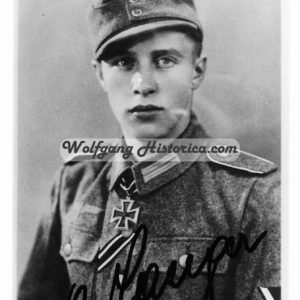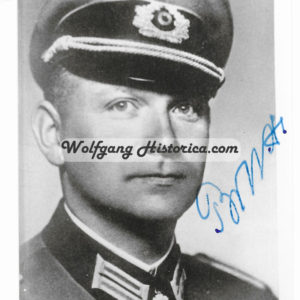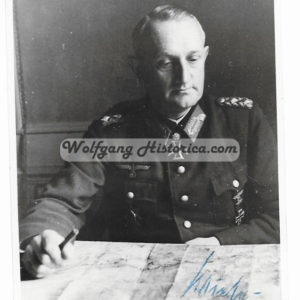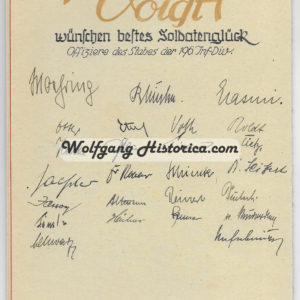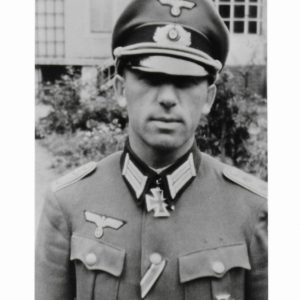Max Kurze – Panzerjäger-Abteilung 187
€30,00
Original Postwar Signature on a Postwar Photocopy of Max Kurze. Major Max Kurze (22.06.1911 † 25.11.1997) earned the Deutsches Kreuz in Gold on December 1, 1943 with Panzerjäger-Kompanie 187 and the Ritterkreuz on September 20, 1944 as Major und Kommandeur of Panzerjäger-Abteilung 187 of the 87. Infanterie-Division. Good Condition. Measuring: 8,5x12,6cm. Comes with an extra signed letter.
Add to Cart
Fritz Kercher – Panzerjäger-Abteilung 5 (Sturmgeschütz)
€35,00
Original Postwar Signature on a Postwar Photocopy of Fritz Kercher. Leutnant Fritz Kercher (11.09.1919 † 12.11.2007) earned the Ritterkreuz on March 6, 1944 as Leutnant und Zugführer of the 1. Kompanie/ Panzerjäger-Abteilung 5 of the 5. Jäger-Division. Good Condition. Measuring: 8,3x12,5cm. Comes with an extra signed letter.
Add to Cart
Hans Ender – Grenadier-Regiment 545 (389. Infanterie-Division)
€27,50
Original Postwar Signature on a Postwar Photocopy of Hans Ender. Hauptmann Hans Ender (06.08.1910 † 11.01.1993) earned the Ritterkreuz on April 5, 1945 as Hauptmann und Kommandeur of the II. Bataillon/ Grenadier-Regiment 545 of the 389. Infanterie-Division. Good condition. Measuring: 8,8x12,5cm. Comes with extra documents.
Knight's Cross: “During the 389. Infanterie-Division’s fierce defensive battles in the Tucheler Moor the enemy launched attacks with the ultimate aim of taking Danzig, an act which would cut off the German resupply and prevent the evacuation of the German civilian population. In this context Hauptmann Ender and his II./Grenadier-Regiment 545 were ordered to defend the Frankenhagen sector (10 km NW of Tuchel), one of the hotspots of the fighting. On the 10.02.1945, following a one hour artillery barrage, the enemy attacked the Bataillon’s flank with strong infantry forces and 18 tanks. Their goal was to tear a hole in our defensive positions and roll them up. This created a dangerous situation for the entire divisional sector. In response the Bataillon commander placed himself at the head of the last reserve forces and succeeded in separating the enemy infantry from their tanks. He and his men were able to destroy 15 tanks, 4 anti-tank guns (7.62 cm) and 5 assault guns in close combat via Panzerfausts. The position was ultimately held by its hard-pressed garrison. Over the course of this 10 hour long defensive battle our own artillery only played a minor support role, meaning that the actual combat was almost exclusively at close range.”
Add to Cart
Reinhold Böhmke – Grenadier-Regiment 162 (61. Infanterie-Division)
€25,00
Original Postwar Signature on a Postwar Photocopy of Reinhold Böhmke. Oberfeldwebel Reinhold Böhmke (25.09.1911 † 12.11.2001) earned the Ritterkreuz on April 6, 1944 as Oberfeldwebel und Zugführer in the 13. Kompanie/ Grenadier-Regiment 162 of the 61. Infanterie-Division. Good condition. Measuring: 8,8x12,5cm. Comes with extra documents.
Knight's Cross: "On the 15.01.1944 Böhmke mastered a critical situation through his own initiative during a Soviet combined arms attack south of Oranienbaum. The Soviets managed to occupy the hill in the rear of I./Grenadier-Regiment 162. At this time Oberfeldwebel Böhmke was serving as the forward observer of an infantry gun Zug, and in the absence of the Bataillon commander (who was fighting at the frontline) he decided to attack the much larger enemy force with a handful of men. He managed to capture the hill in close combat while eliminating several MG nests. In the end an entire Soviet battalion was shattered during the battle."
Add to Cart
Rudolf Fleischer – Heeres-Flak-Abteilung 314
€25,00
Original Postwar Signature on a Postwar Photocopy of Rudolf Fleischer. Major Rudolf Fleischer (21.07.1915 † 13.12.1991) earned the Deutsches Kreuz in Gold on March 9, 1945 as Major und Kommandeur of the Heeres-Flak-Abteilung 314 and the Ritterkreuz on May 9, 1945 as Major und Kommandeur of the Heeres-Flak-Abteilung 314 of the 18. Panzer-Grenadier-Division. Good condition. Measuring: 7,6x11,2cm. Comes with an extra signed letter.
Knight's Cross: "“In the evening hours of the 27.03.1945 the enemy penetrated into Nyirad with strong infantry and tank forces. To prevent a further advance of the enemy towards the south, which would lead them into the flank of the divisions of the IV. SS-Panzer-Korps and the Kavallerie-Korps, friendly infantry were dispatched to the southern edge of the woods south of Nyirad. Major Fleischer and his weak Heeres-Flak-Art. Abt. 314 had the mission of guarding against broken-through enemy tanks coming in from the north from their own positions along both sides of the road at Ujderogs. They were to later pull back alongside the friendly infantry. But following the retreat of the friendly infantry Major Fleischer decided to continue to hold his positions on his own initiative, despite the lack of infantry support and the toughly prosecuted enemy attacks. Through his outstanding personal bravery he inspired his men to hold on time and again. His unit ultimately destroyed 3 enemy tanks and 2 enemy battalions. By this he enabled the divisions of the IV. SS-Panzer-Korps and the Kavallerie-Korps to withdraw. I recommend Major Fleischer for the award of the Knight’s Cross to the Iron Cross.”
Add to Cart
Albert Langer – Grenadier-Regiment 51
€20,00
Original Postwar Signature on a Postwar Photocopy of Albert Langer. Gefreiter Albert Langer (05.09.1924 † 24.05.1993) earned the Ritterkreuz on April 7, 1944 as Gefreiter und Gruppenführer in the 1. Kompanie/ Grenadier-Regiment 51 of the 18. Panzer-Grenadier-Division. Good condition. Measuring: Postcardsize.
Knight's Cross: "At the end of March 1944 the Soviets instigated a fierce battle between the Dnieper and Tschaussy rivers, in which the I./Grenadier-Regiment 51 (mot) was heavily involved. The Germans had by this time suffered heavy losses and after the 2. Kompanie of the Bataillon was no longer combat capable, it came down to 1. Kompanie and its handful of Grenadiers to carry on the fight. Among these was the machine-gunner Gefreiter Langer.
When a Soviet battalion, soon followed by another, commenced an attack on the German Kompanie, Langer was forced to take over control of his squad after its commanding Unteroffizier had fallen out due to a nervous breakdown. Throughout that day and the following night however the squad was able to hold its ground despite the heavy odds. Their situation vastly improved when they finally received an ammunition resupply during the night.
In the end Langer and his squad managed to fend off all strong Soviet attacks for four days during battles that raged both in daylight and darkness. This success was largely on account of Langer’s bravery and decisiveness, and it contributed significantly to the overall defensive triumph of the Bataillon. Thus on the third night of the battle already (26.03.1944) Langer was awarded the Iron Cross First Class and his comrades the Iron Cross Second Class. Afterwards Langer would be recommended for and receive the Knight’s Cross." (Source: Traces of War)
Add to Cart
Karl Bieg – Grenadier-Regiment 868
€25,00
Original Postwar Signature on a Postwar Photocopy of Karl Bieg. Major Karl Bieg (13.09.1909 † 12.10.1993) earned the Ritterkreuz on September 17, 1943 as Hauptmann und Führer of the II. Bataillon/ Grenadier-Regiment 868 of the 355. Infanterie-Division. Good condition. Measuring: 7,8x11,5cm. Comes with an extra signed letter.
Knight's Cross: “During the heavy fighting south of Kharkov Hauptmann Bieg managed to repulse the attacks by overwhelmingly vast enemy forces over the course of 15 consecutive major battle days. Despite being painfully wounded he remained with his Grenadiers and stood steadfast alongside them even though they were all being threatened by the Bolsheviks from the sides and rear. In the following days he and his brave unit fought their way through the enemy encirclement ring and occupied new blocking positions to the rear, once again holding these successfully against all the enemy’s furious attacks.”
Add to Cart
Erich Eichler – Artillerie-Regiment 20 (20. Panzer-Grenadier-Division)
€25,00
Original Postwar Signature on a Postwar Photocopy of Erich Eichler. Hauptmann Erich Eichler (19.08.1914 † 08.03.2003) earned the Ritterkreuz on September 21, 1944 as Hauptmann with the II. Abteilung/ Artillerie-Regiment 20 of the 20. Panzer-Grenadier-Division. Good condition. Measuring: Postcardsize. Comes with an extra signed letter.
Add to Cart
Gerhard Beier – Panzerjäger-Kompanie 1193
€25,00
Original Postwar Signature on a Postwar Photo of Gerhard Beier. Leutnant Gerhard Beier (11.12.1919 † 17.11.2005) earned the Ritterkreuz on March 17, 1945 as Leutnant und Führer of the Panzerjäger-Kompanie 1193 of the 93. Infanterie-Division. Good condition. Measuring: 7x10,2cm. Comes with an extra signed letter.
Add to Cart
Erwin Cohrs – Panzer-Grenadier-Regiment 67 (26. Panzer-Division)
€27,50
Original Postwar Signature on a Postwar Photocopy of Erwin Cohrs. Major Erwin Cohrs (19.02.1916 † 27.02.1994) earned the Deutsches Kreuz in Gold on December 8, 1943 with 6. Kompanie/ Panzer-Grenadier-Regiment 67 and the Ritterkreuz on December 9, 1944 as Major und Kommandeur of the II. Bataillon/ Panzer-Grenadier-Regiment 67 of the 26. Panzer-Division. Good condition. Measuring: 8,5x12,7cm. Comes with an extra signed letter.
Knight's Cross: "During the last days of October 1944 Allied forces made an advance near C. Condoli with strong forces. In response Major Cohrs launched a counterattack with his Grenadiers that threw the Allied troops back across the Savio river with heavy losses. By doing so he removed the impending danger of an Allied breakthrough, which would have had severe consequences for the Division’s entire frontline. Major Cohrs would thus subsequently be awarded the Knight’s Cross."
Add to Cart
Hans Bujak – Grenadier-Regiment 7
€30,00
Original Postwar Signature on a Postwar Photo of Hans Bujak. Oberfeldwebel Hans Bujak (05.02.1914 † 20.03.1990) earned the Ritterkreuz on August 27, 1944 as Feldwebel und Zugführer of the 10. Kompanie/ Grenadier-Regiment 7 of the 252. Infanterie-Division. Good condition. Measuring: Postcardsize. Comes with an extra signed letter.
Knight's Cross: "On the 15.07.1944 the Russians succeeded in breaking into the frontline of the 252. Infanterie-Division in a forest north of Lake Luksias. An immediate counterthrust to seal off this penetration failed, and in the process the commander of the III./Grenadier-Regiment 7 (Hauptmann Gräbsch) fell in battle. During this time Bujak’s Zug (consisting of 21 men) had the mission of holding a hill and a defile between lakes. In the late afternoon of this day the Soviets penetrated between Bujak’s Zug and the lake, and they went on to firmly establish themselves in a forest along the Division’s retreat route. Nonetheless Bujak and his men held their important position. During the evening of the same day a renewed German counterattack with Sturmgeschütz support managed to throw the enemy out of the forest. As the enemy was falling back Bujak struck their flank with a part of his Zug, and by doing so he significantly contributed to the ability of the German forces in this area to definitively resolve this dangerous situation and recapture the old frontline northeast of Lake Luksias."
Knight's Cross: "On the 15.07.1944 the Russians succeeded in breaking into the frontline of the 252. Infanterie-Division in a forest north of Lake Luksias. An immediate counterthrust to seal off this penetration failed, and in the process the commander of the III./Grenadier-Regiment 7 (Hauptmann Gräbsch) fell in battle. During this time Bujak’s Zug (consisting of 21 men) had the mission of holding a hill and a defile between lakes. In the late afternoon of this day the Soviets penetrated between Bujak’s Zug and the lake, and they went on to firmly establish themselves in a forest along the Division’s retreat route. Nonetheless Bujak and his men held their important position. During the evening of the same day a renewed German counterattack with Sturmgeschütz support managed to throw the enemy out of the forest. As the enemy was falling back Bujak struck their flank with a part of his Zug, and by doing so he significantly contributed to the ability of the German forces in this area to definitively resolve this dangerous situation and recapture the old frontline northeast of Lake Luksias."
Add to Cart
Wolfgang von Bostell – Panzerjäger-Abteilung 1023 & 205 (Eichenlaub)
€35,00
Original Postwar Signature on a Postwar Photocopy of Wolfgang von Bostell. Oberleutnant Wolfgang von Bostell (25.02.1917 † 10.05.1991) earned the Ritterkreuz on September 2, 1944 with 2. Kompanie/ Panzerjäger-(Sturmgeschütz-)Abteilung 1023 and the Eichenlaub on April 30, 1945 as Oberleutnant und Führer of the 2. Kompanie/ Panzerjäger-Abteilung 205 of the 205. Panzer-Division. Good Condition. Measuring: Postcardsize. Comes with an extra signed letter.
Add to Cart
- Knight's Cross: "Awarded for destroying 11 enemy tanks and 2 self-propelled guns in the area around Modohn on the 11.-12.08.1944." Oakleaves: "Awarded for distinguishing himself in the Courland bridgehead southeast of Libau, southwest of Frauenburg and in particularly on the 26.03.1945 while southeast of Schrunden. Here he eliminated numerous enemy resistance nests and spearheaded the effort to eliminate a Soviet penetration. This succeeded, with the result that a Soviet regiment was trapped in a tube-like pocket behind the frontline. A portion of these troops broke out, however the remainder were destroyed on the following day."
Wolfram Kertz – Kampfgruppe “Bruhn”
€30,00
Original Postwar Signature on a Postwar Photocopy of Wolfram Kertz. Major Wolfram Kertz (29.07.1916 † 05.05.2009) earned the Ritterkreuz on October 4, 1944 as Oberleutnant und Führer of the 8. Kompanie/ Kampfgruppe "Bruhn" of the II. SS. Panzerkorps. Good condition. Measuring: Postcardsize. Comes with an extra signed letter.
Add to Cart
Franz Griesbach – Grenadier-Regiment 399 (Swords)
€40,00
Original Postwar Signature on a Postwar Photocopy of Franz Griesbach. Generalmajor Franz Griesbach (21.12.1892 † 24.09.1984) earned the Ritterkreuz on March 14, 1942 as Major und Kommandeur of the I. Bataillon/ Infanterie-Regiment 391, the Eichenlaub on May 17, 1943 as Oberst und Kommandeur of Grenadier-Regiment 399 and the Schwertern on March 6, 1944 as Oberst und Kommandeur of Grenadier-Regiment 399 of the 170. Infanterie-Division. Good condition. Postcardsize. Signed on the front (mostly faded but visible) and back.
Read more
Friedrich Buchenau – Fähnrich-Regiment 4 (Division Bärwalde)
€32,50
Original Postwar Signature on a Postwar Photocopy of Friedrich Buchenau. Major Friedrich Buchenau (04.06.1914 † 08.02.1991) earned the Ritterkreuz on March 28, 1945 as Major und Kommandeur of the Fähnrich-Regiment 4 of the Division Bärwalde. Good condition. Measuring: 8,8x11,4cm. Comes with an extra signed letter.
"During their thrust from southern Pomerania towards the Stettin Lagoon the enemy reached the Baltic Sea south of Bad Bievenow, and by doing so they encircled a group of German troops. However this group fought their way through to the Baltic Sea coast and created a bridgehead in the Horst area. The Bolsheviks immediately started an attack against this group in order to crush it once and for all. At the same time our Kampfgruppe launched its own attack in order to force a breakthrough towards the west.
Within this context the Fahnenjunker-Regiment of the Artillerieschule 2 under the command of Major Buchenau had the mission of breaking through the enemy encirclement ring. The officer candidates had neither artillery nor heavy weapons available, but they fought fiercely even so. They fought through the enemy blocking fire, overpowered the enemy infantry and smashed a strong anti-tank gun blocking position. The young soldiers then chose to not take the time to reorder their units, instead they thrust further towards the west. They captured a village and also seized an enemy battery consisting of six 12.2 cm artillery pieces. On the next morning they captured another village, and by doing so they reached the ordered attack objective.
The exemplary fighting spirit of these officer candidates enabled the Kampfgruppe to break through to our Stettin bridgehead while taking along all wounded soldiers and attached civilians. During this fighting they captured or destroyed 3 tanks, 4 armoured cars, 40 anti-tank guns, 6 artillery pieces, 15 super-heavy mortars, numerous anti-tank rifles, uncounted numbers of machine-guns and small arms as well as a large quantity of trucks and motorcycles.”
Add to Cart
Johann Biehl – Infanterie-Regiment 124
€15,00
Original Postwar Signature on a Postwar Photo of Johann Biehl. Feldwebel Johann Biehl (29.01.1917 † 12.03.2017) earned the Ritterkreuz on July 30, 1942 as Feldwebel und Zugführer in the 2. Kompanie/ Infanterie-Regiment 124 of the 72. Infanterie-Division. Good condition. Postcardsize.
Add to Cart
Heinz Behnke – Grenadier-Regiment 668
€20,00
Original Postwar Signature on a Postwar Photo of Heinz Behnke. Oberleutnant Heinz Behnke (01.10.1919 † 17.02.2002) earned the Ritterkreuz on January 20, 1944 as Leutnant und Zugführer in 14. Kompanie/ Grenadier-Regiment 668 of the 360. Infanterie-Division. Good condition. Measuring 8,7x12,5cm.
Add to Cart
Günter Braake – Grenadier-Regiment 422 (126. Inf.-Div.)
€25,00
Original Postwar Signature on a Postwar Photo of Günter Braake. Hauptmann Günter Braake (10.04.1921 † 21.05.2016) earned the Ritterkreuz on August 27, 1944 as Oberleutnant und Stellvertretender Führer of I. Bataillon/ Grenadier-Regiment 422 of the 126. Infanterie-Division. Good condition. Postcardsize. Comes with an extra signed letter.
Add to Cart
Günter Braake – Grenadier-Regiment 422 (126. Inf.-Div.)
€30,00
Original Postwar Signature on a Postwar Photo of Günter Braake. Hauptmann Günter Braake (10.04.1921 † 21.05.2016) earned the Ritterkreuz on August 27, 1944 as Oberleutnant und Stellvertretender Führer of I. Bataillon/ Grenadier-Regiment 422 of the 126. Infanterie-Division. Good condition. Postcardsize. Comes with an extra signed letter.
Add to Cart
Karl-Günther von Hase – Kommandant Festung Schneidemühl
€30,00
Original Postwar Signature on a Postwar Photocopy of Karl-Günther von Hase. Major im Generalstab Karl-Günther von Hase (15.12.1917 † ) earned the Deutsches Kreuz in Gold on February 11, 1943 with Panzer-Artillerie-Regiment 92 and the Ritterkreuz on February 12, 1945 as Generalstabs Offizier with Kommandant Festung Schneidemühl (Ia Panzer-Division "Holstein"). Good condition. Good condition. Measuring 11,7x16,5cm. Comes with an extra signed letter.
Add to Cart
Alois Eisele – Grenadier-Regiment 61 (EL+NKIG)
€55,00
Original Postwar Signature on a Postwar Photocopy of Alois Eisele. Major Alois Eisele (22.02.1914 † 04.12.2008) earned the Deutsches Kreuz in Gold on July 17, 1943 with Grenadier-Regiment 61, the Ritterkreuz on December 15, 1943 as Hauptmann und Kommandeur of the III. Bataillon/ Grenadier-Regiment 61 and the Eichenlaub on January 12, 1945 as Major und Kommandeur of the III. Bataillon/ Grenadier-Regiment 61 of the 7. Infanterie-Division. Eisele also earned the Nahkampfspange in Gold on December 15, 1944. Good condition. Good condition. Measuring 8,2x11,8cm. Comes with an extra signed document.
Add to Cart
Arthur Jüttner – Grenadier-Regiment 532 & 164 (Swords)
€40,00
Original Postwar Signature on a Postwar Photocopy of Arthur Jüttner. Oberst Arthur Jüttner (18.08.1908 † 01.12.2003) earned the Deutsches Kreuz in Gold on February 27, 1943 with Jäger-Regiment 38, the Ritterkreuz on December 14, 1941 as Hauptmann und Kommandeur of the III. Bataillon/ Infanterie-Regiment 38 of the 8. Infanterie-Division, the Eichenlaub on August 18, 1944 as Oberst und Kommandeur of Grenadier-Regiment 532 of the 383. Infanterie-Division and the Schwertern on April 5, 1945 as Oberst und Kommandeur of Grenadier-Regiment 164 of the 62. Volks-Grenadier-Division. Good condition. Postcardsize. Comes with 2 extra documents.
Add to Cart
Heinrich Keese – Pionier-Bataillon 20 (Oakleaves)
€35,00
Original Postwar Signature on a Postwar Photocopy of Heinrich Keese. Major Heinrich Keese (28.04.1918 † 27.05.2006) earned the Deutsches Kreuz in Gold on January 3, 1944 with Pionier-Bataillon 20, the Ritterkreuz on October 20, 1944 as Oberleutnant und Chef of the 2. Kompanie/ Pionier-Bataillon 20 and the Eichenlaub on March 28, 1945 as Major und Kommandeur of the Pionier-Bataillon 20 of the 20. Panzer-Grenadier-Division. Good condition. Measuring 8,8x12,8cm. Comes with an extra signed letter.
Add to Cart
Gerhard Witte – Panzer-Grenadier-Regiment 25
€30,00
Original Postwar Signature on a Postwar Photocopy of Gerhard Witte. Major Gerhard Witte (02.02.1916 † 16.04.2009) earned the Deutsches Kreuz in Gold on January 20, 1944 with Panzer-Grenadier-Regiment 25 and the Ritterkreuz on August 23, 1944 as Major und Kommandeur of the II. Bataillon/ Panzer-Grenadier-Regiment 25 of the 12. Panzer-Division. Good condition. Measuring 8,8x12,8cm. Comes with an extra signed letter.
Add to Cart
Hans Fiedler – Grenadier-Regiment 309
€20,00- Original Postwar Signature on a Postwar Photocopy of Hans Fiedler. Oberfeldwebel Hans Fiedler (01.12.1919 † 06.07.1997) earned the Ritterkreuz on February 18, 1945 as Oberfeldwebel und Kompanie-Truppführer in the 9. Kompanie/ Grenadier-Regiment 309 of the 208. Infanterie-Division. Good condition. Postcardsize.
Wilhelm Köhler – Grenadier-Regiment 195 & 9. Panzer-Division
€30,00
Original Postwar Signature on a Postwar Photocopy of Wilhelm Köhler. Hauptmann Wilhelm Köhler (26.01.1917 † 30.09.2002) earned the Ritterkreuz on December 10, 1942 as Hauptmann und Kommandeur of a Kampfgruppe/ Grenadier-Regiment 195 of the 78. Infanterie-Division and the Eichenlaub on October 4, 1944 as Hauptmann und Ordonnanzoffizier of Kampfgruppe/ 9.Panzer-Division. Good condition. Measuring 17,5x11,5cm.
Add to Cart
Ludwig Lang – Artillerie-Regiment 7
€20,00
Original Postwar Signature on a Postwar Photocopy of Ludwig Lang. Oberleutnant Ludwig Lang (24.03.1920 † 05.01.2013) earned the Ritterkreuz on October 6, 1944 as Oberleutnant und Batteriechef of the 2. Batterie/ Artillerie-Regiment 7 of the 7. Infanterie-Division. Good condition. Postcardsize.
Add to Cart
Johannes Koll – Grenadier-Regiment 696 (340. Inf.-Div.)
€20,00
Original Postwar Signature on a Postwar Photo of Johannes Koll. Oberleutnant Johannes Koll (30.01.1923 † 07.08.2007) earned the Ritterkreuz on December 24, 1944 as Leutnant und Führer of the 2. Kompanie/ Grenadier-Regiment 696 of the 340. Infanterie-Division. Good condition. Postcardsize.
Add to Cart
Heinz-Georg Ritter – Grenadier-Regiment 44
€20,00
Original Postwar Signature on a Postwar Photocopy of Heinz-Georg Ritter. Major Heinz-Georg Ritter (26.05.1917 † 10.03.2010) earned the Ritterkreuz on April 20, 1945 as Hauptmann und Kommandeur of the II. Bataillon/ Grenadier-Regiment 44 of the 11. Infanterie-Division. Good condition. Postcardsize.
Add to Cart
Richard John – Grenadier-Regiment 445 (134.Inf.Div.)
€15,00
Original Postwar Signature on a Postwar Photocopy of Richard John. Feldwebel Richard John (14.11.1916 † 21.06.2010) earned the Ritterkreuz on May 4, 1944 as Feldwebel und Kompanie-Truppführer in the 2. Kompanie/ Grenadier-Regiment 445 of the 134. Infanterie-Division. Good condition. Postcardsize.
Add to Cart
Rudolf Kendler – Panzer-Aufklärungs-Abteilung 4
€20,00
Original Postwar Signature on a Postwar Photocopy of Rudolf Kendler. Hauptmann Rudolf Kendler (15.04.1914 † 13.02.2011) earned the Deutsches Kreuz in Gold on May 29, 1943 as Oberleutnant in the 4. Kompanie/ Kradschützen-Bataillon 165 of the 16. Infanterie-Division and the Ritterkreuz on September 2, 1944 as Hauptmann und Führer of the Panzer-Aufklärungs-Abteilung 4 of the 4. Panzer-Division. Good condition. Postcardsize.
Knight's Cross: "On the 30.07.1944 Hauptmann Kendler and his Aufklärungs-Abteilung launched an assault from Grodzisk and took the villages of Mendle, Grodzisk and Kozolo despite fierce Soviet resistance. Kampfgruppe Kendler was then able to restore contact with 2. Armee in the village of Drochlin when it linked up with the Armee Sturmbataillon. Kendler would be decorated with the Knight’s Cross for his actions and bravery during these battles."
Add to Cart
Rudolf Schier – Jäger-Regiment 49
€20,00
Original Postwar Signature on a Postwar Photocopy of Rudolf Schier. Hauptmann Rudolf Schier (16.06.1914 † 02.09.2004) earned the Deutsches Kreuz in Gold on August 17, 1944 as Hauptmann in the III. Bataillon/ Jäger-Regiment 49 and the Ritterkreuz on February 14, 1945 as Hauptmann und Kommandeur of the III. Bataillon/ Jäger-Regiment 49 of the 28. Jäger-Division. Good condition. Postcardsize.
Add to Cart
Klaus Ritter – Grenadier-Regiment 67 (23. Inf.-Div.)
€20,00
Original Postwar Signature on a Postwar Photo of Klaus Ritter. Hauptmann Klaus Ritter (18.09.1918 † 27.01.2015) earned the Ritterkreuz on October 28, 1944 as Hauptmann und Führer of the II. Bataillon/ Grenadier-Regiment 67 of the 23. Infanterie-Division. Good condition. Postcardsize.
Add to Cart
Jozef-Georg Mulzer – Pionier-Bataillon 195 (95. Inf.-Div.)
€20,00
Original Postwar Signature on a Postwar Photo of Josef-Georg Mulzer. Major Josef-Georg Mulzer (15.04.1915 † 21.01.2011) earned the Ritterkreuz on September 7, 1943 as Major und Kommandeur of the Pionier-Bataillon 195 and the Eichenlaub on January 10, 1944 as Major und Kommandeur of the Pionier-Bataillon 195 of the 95. Infanterie-Division. Good condition. Postcardsize.
Knight's Cross: "Major Mulzer fought with his Pionier-Bataillon in the sector of the 95. Infanterie-Division during the fighting for the Orel salient in mid-1943. In this time he and his men cleaned up numerous Soviet penetrations via energetic counterattacks and, on one occasion, he recaptured a commanding height in an attack launched on his own initiative. Mulzer would receive the Knight’s Cross for these actions."
Oakleaves: "Near the end of 1943 the Pionier-Bataillon 195 occupied a defensive sector west of Bobruisk. Following an artillery barrage the Soviets attacked this sector with significant forces on a broad front. With his last reserves, namely soldiers from his staff as well as some drivers, Major Mulzer was able to eject the Soviet soldiers from his position and bring the attack in his sector to a halt. Meanwhile however the Soviets had managed to break through in the right neighbouring sector, and from here they threatened to roll up the whole Division’s frontline. Mulzer quickly recognized this danger and, assembling as many soldiers as could be spared, he launched a flank attack against this new opposing force. After a short but violent battle, the Soviets here fled after having suffered heavy losses. Major Mulzer then threw up a temporary defensive front and was able to hold it against all new hostile breakthrough attempts until the arrival of reinforcements. Through his bravery and decisiveness, Mulzer had thus averted a great danger for the whole German frontline west of Bobruisk. He would thus be awarded the Oakleaves to his Knight’s Cross."
Add to Cart
Johannes Eikmeier – Reiter-Regiment 32
€25,00
Original Postwar Signature on a Postwar Photocopy of Johannes "Hans" Eikmeier. Major Johannes Eikmeier (03.12.1918 † 05.09.2012) earned the Deutsches Kreuz in Gold on January 25, 1943 as Oberleutnant in the Aufklärungs-Abteilung 120 and the Ritterkreuz on September 30, 1944 as Rittmeiter und Führer with II. Bataillon/ Reiter-Regiment 32 of the 3. Kavallerie-Brigade. Good condition. Postcardsize.
Add to Cart
Johann Pongratz – Infanterie-Regiment 74
€20,00
Original Postwar Signature on a Postwar Photocopy of Johann Pongratz. Hauptmann Johann Pongratz (19.01.1913 † 01.08.1997) earned the Ritterkreuz on September 4, 1940 as Oberfeldwebel und Zugführer with 2. Kompanie/ Infanterie-Regiment 74 of the 19. Panzer-Division. Good condition. Postcardsize.
Add to Cart
Albert Brux – Schützen-Rgt. 66 & Panzer-Grenadier-Rgt. 40 (Oakleaves)
€30,00
Original Postwar Signature on a Postwar Photo of Albert Brux. Oberst Albert Brux (11.11.1907 † 16.12.2001) earned the Ritterkreuz on September 12, 1941 as Hauptmann und Kommandeur of the I. Bataillon/ Schützen-Regiment 66 of the 13. Panzer-Division, the Deutsches Kreuz in Gold on January 23, 1943 as Major with Kradschützen-Bataillon 43 and the Eichenlaub on June 24, 1944 as Oberst und Kommandeur of the Panzer-Grenadier-Regiment 40 of the 17. Panzer-Division. Good condition. Measuring: Postcardsize.
Add to Cart
Theodor Populo – Schützen-Regiment 4
€25,00
Original Postwar Signature on a Postwar Photocopy of Theodor Populo. Theodor Populo (30.01.1916 † 18.05.2010) earned the Ritterkreuz on July 27, 1941 as Leutnant und Führer of the 7. Kompanie/ Schützen-Regiment 4 of the 6. Panzer-Division. Good condition. Postcardsize. Comes with an extra signed letter.
Add to Cart
Johannes Schmidt – Panzer-Regiment 27
€22,50
Original Postwar Signature of Dipl.-Ing. Johannes Schmidt. Dipl.-Ing. Johannes Schmidt (30.09.1899 † 10.11.1987) earned the Deutsches Kreuz in Gold and Ritterkreuz on October 15, 1942 as Oberstleutnant and Kommandeur of the III. Abteilung/ Panzer-Regiment 27 of the 19. Panzer-Division. Measuring 7,5x11,5 cm.
Add to Cart
Friedrich Wiese – Infanterie-Regiment 38 & XXXV. Armeekorps (Oakleaves)
€75,00
Original Postwar Signature on a Postwar Photo of Friedrich Wiese. General der Infanterie Friedrich Wiese (05.12.1892 † 13.02.1975) earned the Ritterkreuz des Eisernen Kreuzes on February 14, 1942 as Oberst und Kommandeur of Infanterie-Regiment 39 of the 26. Infanterie-Division and the Eichenlaub on January 24, 1944 as General der Infanterie und Kommandeur of the XXXV. Armeekorps. Condition as seen. Postcardsize.
Read more about Friedrich Wiese (Wikipedia).
Add to Cart
‘Soldatenglück’ Signed by Divisional Staff of 196. Infanterie-Division (Kurt Möhring!)
€110,00
Stunning fieldmade and handsigned 'Soldatenglück' document (DIN A4, can be opened) with “Dem Scheidenden techn. Inspektor (K) Voigtl wünschen bestes Soldatenglück” (The departing techn. Inspector (K) Voigtl, wishes the best 'Soldier's luck'), “Offiziere des Stabes der 196. Infanterie-Division” (Officers of the Divisional Staff of the 196. Infanterie-Division). This document was handsigned by all of the Divisional Staff officers of the Division!
The 196. Infanterie-Division was engaged in the fightings and occupation of Drontheim (Trondheim), Norway. A stunning and researchable document from a Division serving years on the Norwegian front! One of the signatures is from the Divisional Commander Generalleutnant Kurt Möhring (Knight’s Cross and was Killed in Action during the Battle of the Bulge as Commander of the 276. Volks-Grenadier-Division). On December 18, 1944 Major-General Kurt Moehring, was on his way back to his command post when he got killed in his staff car near the village of Beaufort by machinegun fire. Interestingly, his command car was an American jeep and his death is disputed due the American took credit for his death but according to local historians there were no US troops within that area 48 hours after the offensive.
A few identified signatures are that of: Generalleutnant Kurt Moehring (Commander) and Oberstleutnant Klimke (Ia). Robert Alber – Panzer-Regiment 201
€18,00
Postwar Signature of Robert Alber, Knight's Cross Holder of Panzer-Regiment 201 / 23. Panzer-Division.
Add to Cart






